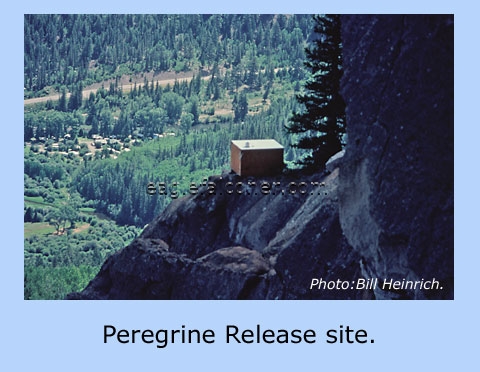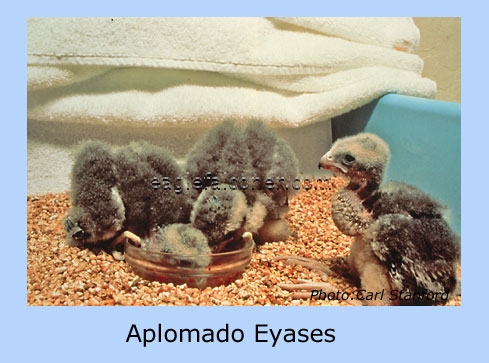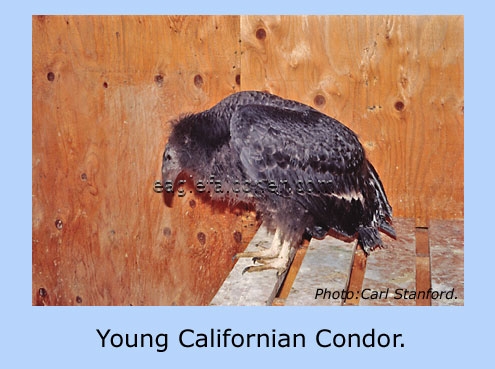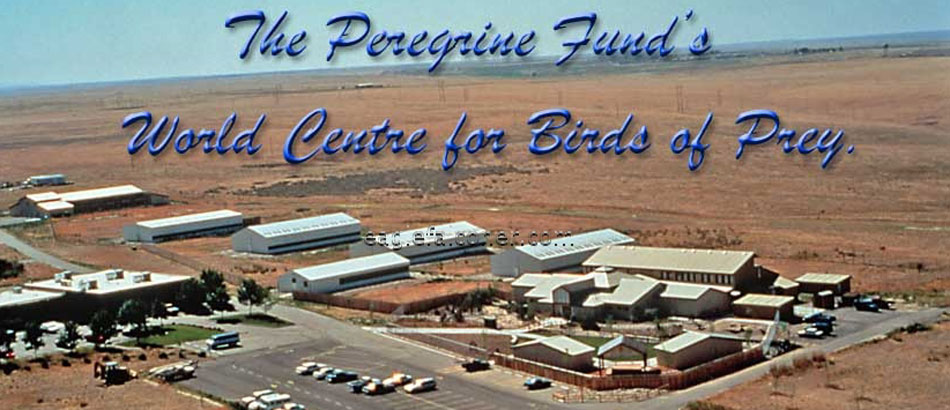As a species, man has the intuitive ability to mess up his environment at an ever increasing pace. One man made disaster after another seems to avail our sensors via the television medium. As a mere individual we can often feel inadequate as these terrible events unfold, with a feeling of helplessness to the prevention, and an inadequacy to the enormity of the task of recovery.
Not all environmental disasters are of such immediate impact, some insidiously creep up on us, unaware of the cumulative effect our attention is not focused until a sudden species population crash alerts dedicated individuals monitoring the environment. Then, these same dedicated few, face an enormous uphill struggle to convince the rest of the population to mend its ways before its to late.
 In 1970, one such scenario faced Tom Cade then a Professor of Ornithology at Cornell University in the United States. In 1970, one such scenario faced Tom Cade then a Professor of Ornithology at Cornell University in the United States.
After the widespread use of DDT and other chlorinated hydrocarbon pesticides, the Peregrine falcon population plummeted during the 1950’s and 60’s. By the end of the 60’s the peregrine was extinct in the Eastern United States and reduced by 90% in the West.
The Peregrine Fund was born from the shared concern of Cade, his students and other eminent falconers, who developed a method of breeding peregrines in captivity.
Together with pioneering successful methods for the release of the captive bred falcons to the wild, made this the most successful breeding and progeny release conservation program of the 20th century.
To date the Fund has released over 4,000 captive bred falcons in 28 states, the Peregrine faced extirpation, its fate has been turned around by those dedicated individuals whose foresight and dogged determination helped repair the damage caused by Man’s careless assault with chemicals on the delicate ecosystem.
The Peregrine is well and truly saved in the United States and has now been proposed to be removed from the list of endangered and threatened species.
Falconers should be proud in the knowledge of the part they played, which achieved the largest and most successful captive breeding and release project of an endangered species, anywhere on the globe.
In 1984 The Peregrine Fund consolidated the Cornell facility and the Ft. Collins, Colorado facility to the current location in Boise, Idaho.
Following the success with the propagation and release of Peregrine Falcons, together with the first successful releases of Bald Eagles and helping to save the Mauritius Kestrel from extinction. The Fund was able to expand its expertise within the new facility at Boise, named the World Centre for Birds of Prey.
The endangered Aplomado Falcon, a medium sized steel grey falcon once ranged throughout the south-western United States and Mexico. When the Spaniards came to the grasslands of Texas and New Mexico the Aplomado falcon was part of the landscape. It declined dramatically during the early part of this century and any that remained in the United States were finished off with the wide spread use of chlorinated hydrocarbon insecticides that had so effectively accounted for the demise of the Peregrine. Now rarely ever seen in the U.S. and Northern Mexico since the 1940’s. the Aplomado Falcon was a prime candidate for the Centres attention. They have released over 100 Aplomado Falcons.
In July 1996 six young captive bred Aplomado Falcons chicks left the Boise Centre for the Matagorda Island National Wildlife Refuge (NWR) near Corpus Christi, Texas. The young falcons were released on Matagorda Island with great expectations after the previous years discovery of the first Aplomado Falcons nest in 54 years. It was a great boost for conservation, with the Centres continued improvements in captive propagation and the apparent desire of the falcons to nest provides the hope of the species eventual recovery.
Continued research may prove beneficial to all as the Aplomado Falcon represents an important “indicator” of environment quality. With its unique ecological position at the very pinnacle of the food pyramid, blood samples taken from this species, over time, can provide biologists with important insight concerning the relative level of environment contamination found in their habitat. Contaminant levels are of particular concern in south Texas, which exhibits the highest incidence of human brain stem birth defects found anywhere in the United States. Blood samples taken before the Aplomados were released and every six months thereafter may provide some answers to this problem.
 In the 1980’s there were only 21 or 22 California Condors total left in the wild or captivity. It became clear to conservationists that emergency measures would have to be taken to save the species from extinction. In 1987, all of remaining wild condors were captured to ensure their safety and to serve as parents in captive breeding programs at the Los Angeles Zoo and the San Diego Wild Animal Park. In the 1980’s there were only 21 or 22 California Condors total left in the wild or captivity. It became clear to conservationists that emergency measures would have to be taken to save the species from extinction. In 1987, all of remaining wild condors were captured to ensure their safety and to serve as parents in captive breeding programs at the Los Angeles Zoo and the San Diego Wild Animal Park.
The Condors soon adapted to their captive environment and the first successful breeding of California Condors was accomplished in 1988.
By 1995 the condor population had grown to 103 individuals, and in 1992, recovery program biologists began releasing captive-produced young condors back into the wild at wilderness sites in the species former range in California.
The World Centre currently houses ten pairs of this rare species, which consists mostly of immature condors just now reaching reproductive age.
Success came in the 1996 season with the Centres first hatching of a California Condor and the first of this endangered species known to have been hatched outside of the State of California since the 1930s, when a small population still occurred in Baja California, Mexico.
The parents of the chick, Tecuya and Shasta, are the oldest pair of the Centres condors (12 and 6 years old, respectively), and this was their first fertile egg. The previous year this pair had laid two infertile eggs, and the second egg was replaced by a fertile Andean Condor egg obtained from the National Zoo. The Andean Condor is a similar large vulture from South America. The pair successfully hatched and raised the young condor. This excellent result gave the Centre confidence to leave the condors with their own egg the following year, which was successfully reared. Other pairs of condors at the Centres facility have laid infertile eggs, and one more pair have hatched and raised a foster Andean Condor.
 In Co-operation with the U.S. Fish & Wildlife Service, California Condors propagated at the San Diego Wild Animal Park and Los Angeles Zoo, together with the young condor from the Centre were flown to a new home in Arizona on the Vermilion Cliffs near the Grand Canyon. In Co-operation with the U.S. Fish & Wildlife Service, California Condors propagated at the San Diego Wild Animal Park and Los Angeles Zoo, together with the young condor from the Centre were flown to a new home in Arizona on the Vermilion Cliffs near the Grand Canyon.
The condors were placed in six adjoining plywood “apartments” facing a 20 by 40 foot release pen. After an acclimatisation period of several days the condors were allowed into the release pen to mingle and to become better acquainted as family members.
The release was supervised by The Peregrine Fund, and these condors are the first of their species to be seen in Arizona since 1924. The Fund is developing its release expertise gained over the past twenty years, as this is the first time a group of non-human reared condors have been released to the wild. Researches will closely monitor the development of social and survival skills of this population to refine captive breeding and reintroduction techniques.
The Harpy Eagle is vulnerable to local extinction because its reproductive rate is very slow. Three years pass between the production of a chick at a nesting tree and the following nesting attempt. These powerful raptors are threatened by the fragmentation and destruction of forests and by people who shoot them.
The Peregrine Fund keep records of sightings of these rare eagles to improve understanding of their distribution. Field work in Venezuela and Panama is yielding important data on the species in the wild. Eleven nests in Panama and twenty nests in Venezuela are currently being studied. With assistance from NASA, satellite transmitters have been attached to eleven young eagles and are being tracked by ARGOS satellites. This information will be used to determine how much area they need to survive.
The World Centre is approaching the Harpy Eagle Conservation Program in a two pronged effort, as well as the important field work, this species is being successfully bred at the World Centre. Two of the four Harpy Eagles to be hatched in captivity in the U.S. were born at the World Centre from the five pairs of unreleasable eagles housed there. This progeny will be used to build the breeding stock or for release in areas where the species is extinct but suitable habitat remains. The first release of captive produced Harpy Eagles is planned for 1997.
The Peregrine Fund is involved with a number of additional conservation projects around the world with species such as the Philippine Eagle, Mauritius Kestrel, Madagascar Fish-Eagle, Orange-breasted Falcon, Alala or Hawaiian Crow and Hawaiian forest songbirds.
The Peregrine Fund’s facility in Boise, Idaho may have an august title, but there is little doubt that it is a world class organisation with a first rate dedicated team of highly motivated people. Although it will always be remembered for its successful role in the reversal of the peregrines fortunes in the United States, its continued commitment to research, education and improved propagation and release techniques of endangered raptor species throughout the world, ensures the Peregrine Fund a place at the heart of raptor conservation. |
